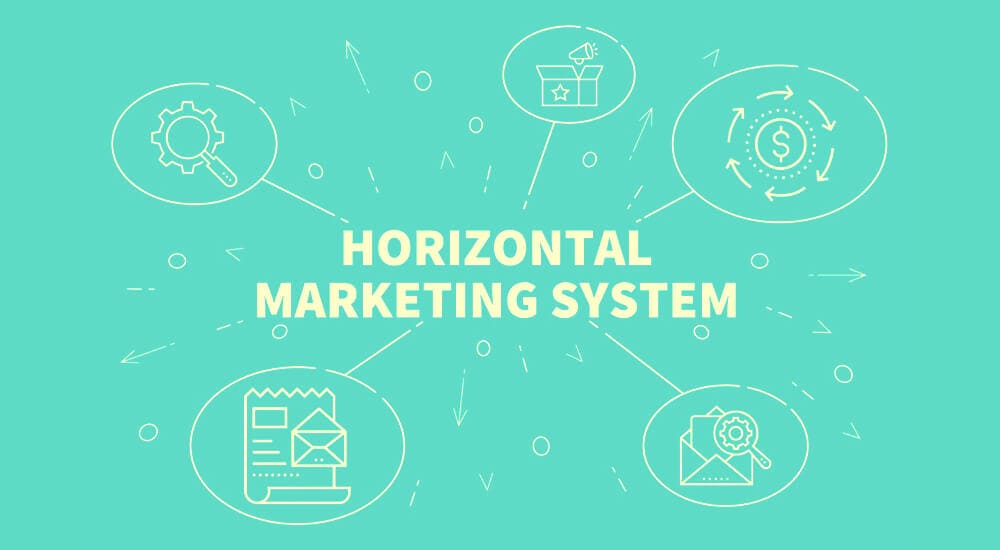A Horizontal Marketing System (HMS) is a distribution channel arrangement between two or more organizations on the same level (but unrelated markets) to join and get the benefits of each other’s expertise and economies of scale.
This strategy helps save money, time, and effort and earns them profit, and increases brand awareness.
Horizontal marketing is common in small to medium-sized industries lacking funding and resources. So, they partner with others to compensate for their shortcomings. The horizontal marketing system is gaining momentum due to fierce competition and new entrants’ desire to capture market share.

A famous example of this strategy is the partnership between Apple and Starbucks.
Apple exclusively allowed Starbucks’ Wi-Fi users to download songs from the iTunes store when they launched iTunes. Apple sold over one million songs through this partnership within the first six days of the launch, and Starbucks was a major contributor.
The collaboration between two manufacturers to optimize resources and gain advanced skills, wholesalers to cover larger areas cheaper, and retailers to benefit from economies of scale.
Another example of a horizontal marketing system is the merger between Facebook and Instagram. This merger gave Instagram and Facebook a wider audience to market and sell their services.
Examples of Horizontal Marketing Systems
The following are a few examples of Horizontal Marketing Systems:
Joint Ventures: A joint venture is formed when two companies at the same level in the supply chain create a new entity to meet shared goals. For example, two car manufacturers might collaborate to design a new electric vehicle. By pooling resources, expertise, and technology, they share risks and costs while developing a product that reflects the strengths of both partners.
Strategic Alliance: In a strategic alliance, businesses at the same level work together without forming a new entity. For instance, two airlines might agree to share flight codes, offering passengers access to a broader network of destinations. This collaboration helps them remain independent while enhancing customer service, market presence, and competitiveness.
Cross Promotions: Cross promotions involve businesses promoting one another’s products or services for mutual benefit. For example, a coffee shop might partner with a bookstore, offering discounts on coffee when buying books. This partnership targets shared audiences, boosts marketing reach, and attracts more customers, increasing sales for both companies.
Co-Branding Partnership: Co-branding partnerships occur when two companies combine their brands to create a single product or service. For example, a smartphone company might partner with a renowned camera brand to produce a phone with advanced photography capabilities. This collaboration leverages both brands’ strengths, creating a unique product that stands out in the market and benefits both businesses.
Types of Horizontal Marketing Systems
Horizontal Marketing Systems can be of three types:
1. Multi Manufacturers: This type of HMS occurs when multiple manufacturers collaborate to produce or market a product. For example, a car manufacturer might collaborate with an electronics company to create vehicles with advanced entertainment systems. By working together, they pool expertise, reduce costs, and reach broader markets effectively.
2. Multi Wholesalers: In this system, wholesalers join forces to expand their distribution networks and improve market access. For instance, two competing food distributors may collaborate to offer a shared inventory to retailers. This arrangement helps them optimize resources, reduce logistics costs, and better serve their customers.
3. Multi Retailers: Multi-retailers collaborate to enhance customer experience and attract more buyers. For example, a clothing store might partner with a shoe retailer to provide a joint shopping event. This cooperation increases foot traffic, boosts sales, and effectively allows them to leverage each other’s customer base.
Benefits of Horizontal Marketing System
- Resource Sharing: Companies can pool resources, including finances, technology, and expertise, reducing individual costs.
- Market Expansion: Collaboration allows access to new markets and broader customer bases.
- Cost Efficiency: Sharing distribution, advertising, and production expenses lowers overall costs.
- Reduced Competition: Partnerships minimize competition by working together rather than against each other.
- Faster Innovation: Collaboration speeds up product development and innovation through combined expertise.
- Stronger Brand Presence: Joint efforts amplify marketing reach and strengthen brand visibility.
- Improved Customer Service: Cooperation improves product availability, delivery options, and overall customer experience.
Summary
Horizontal marketing systems are widely used in today’s business world. Companies at the same level join forces to capitalize on shared opportunities and achieve mutual growth. By collaborating, merging, or combining resources, businesses create stronger, more competitive entities.
These partnerships help reduce costs, expand market reach, and improve customer satisfaction. Organizations can overcome challenges and innovate faster through cooperation, making horizontal marketing systems a powerful strategy for sustainable success in an increasingly interconnected marketplace.
